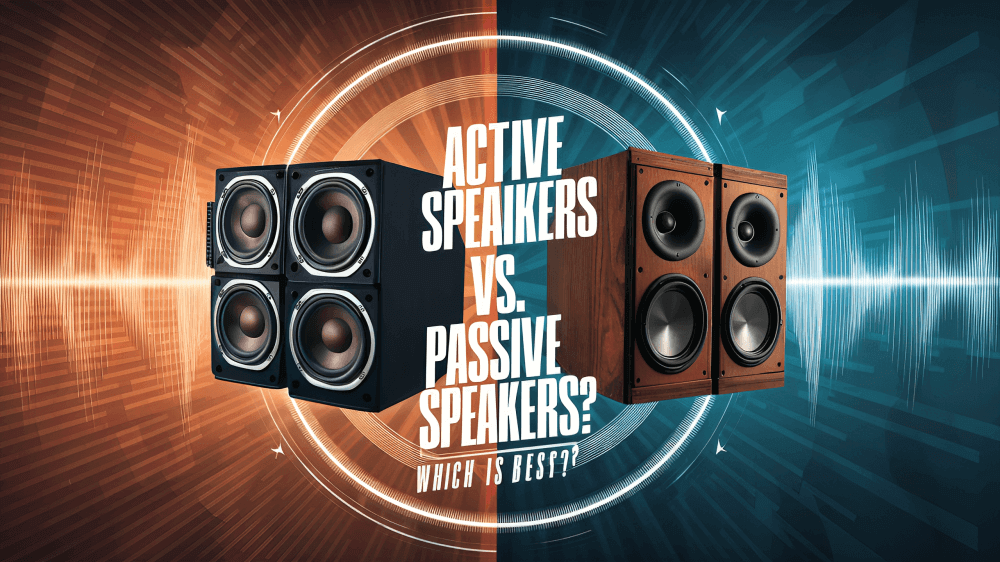Active Speakers vs. Passive Speakers: Which is Best?

In this comparison, we’ll examine two types of speakers: active and passive. These speakers are used for listening to music or watching movies, and are designed to produce sound through various kinds of speakers. They have a built-in power source, which means they don’t require an external amplifier. Passive speakers, on the other hand, rely on an external amplifier.
We’ll explore the Pros and Cons of each type, where they work best, and answer some common questions you may have to help you choose the right speakers for your needs. Just get your Scuba diving equipment ready! Because we are going to dive deep!
Let’s get started!
What Are Active Speakers? The Definitions!
Active speakers come with a built-in power source. This means they have an amplifier inside them, which is like a mini engine that makes the perfect sound. You don’t need to buy a separate amplifier to use active speakers. These speakers are often compact and convenient to use.
What Are Passive Speakers?
Passive speakers are another type of speaker, but they differ slightly. Unlike active speakers, passive speakers don’t have a built-in amplifier. Instead, they rely on an external amplifier to make sound. You have to connect these speakers to an amplifier, and the amplifier powers them up and makes the sound that the speakers are known for. They are known for their flexibility in working with different types of amplifiers, which can be a good thing if you want to customize your sound system.
Active Speakers vs. Passive Speakers: Which is The BEST?
Firstly, we will explore more about these speakers and deep dive into the Pros and Cons of these speakers. Take a look so that you will get a perfect idea of each of your desired decisions.
Let’s Talk about the Pros and Cons of Active Speakers
Active speakers are also known as powered speakers. They are compatible with a wide range of audio sources, including music players, computers, and televisions.
However, active speakers have some downsides, like a higher initial cost compared to passive speakers, and they may have limitations in terms of upgradeability. We’ll explore these pros and cons further.
Pros of Active Speakers:
- Built-in Amplification:
The most notable advantage of active speakers is the presence of a built-in amplifier. This feature is the primary reason for needing a separate amplifier, simplifying your audio setup.
- Compact and Convenient:
Active speakers are often self-contained. You can place them in many locations without the need for additional bulky equipment. These speakers are suitable for smaller spaces.
- Versatility:
Powered speakers are suitable for a wide range of audio sources, such as music players, computers, smartphones, and televisions. This versatility makes them a popular choice for home audio setups.
Cons of Active Speakers:
- Limited Upgradeability:
Active speakers typically have a fixed amplifier that cannot be easily upgraded or replaced. If you wish to improve the power or quality of your sound system, you may need to replace the entire speaker.
- Higher Initial Cost:
Due to the integrated amplification and convenience they offer, active speakers can be more expensive upfront compared to passive speakers.
In short, active speakers are known for their simplicity, space-saving design, and ease of use. Your choice between active and passive speakers will depend on your specific audio needs and preferences.
Cases of Active Speakers: Where Can I Use Active Speakers?
Thanks to their built-in amplification and user-friendly design, they find applications in various scenarios. Here are some everyday use cases where active speakers can be the best fit.
- Home Theater: Their compact size and integrated amplification make them ideal for creating an immersive audio experience without the need for a separate amplifier.
- Turntables: If you’re into vinyl records and turntables, active speakers can be a convenient choice. You can connect your turntable directly to active speakers, making it easier to enjoy your vinyl collection without the need for additional equipment.
- Car Audio: In-car audio systems benefit from the simplicity of active speakers. They can be installed without the need for external amplifiers, making them a space-saving solution for improving your car’s audio quality.
- DJing: These speakers offer portability and ease of use, allowing DJs to set up quickly and focus on their performance without the hassle of connecting external amplifiers.
Let’s Talk about the Pros and Cons of Passive Speakers
In simple terms, some speakers don’t have built-in amplifiers. Unlike active speakers, which come with an amplifier inside, passive speakers rely on an external amplifier to make sound.
Customization and Upgrade Options: One of the significant advantages of passive speakers is the customization and upgrades. You have the option to customize them and the components according to your preferences. This makes them a favorite among audiophiles.
Lower Initial Cost: Passive speakers tend to be more budget-friendly upfront compared to active speakers. This affordability can be appealing, especially for those starting with a limited budget.
Suitable for High-End Audio Setups: Passive speakers are highly regarded in the world of high-end audio systems. Their ability to work harmoniously with a variety of amplifiers and components makes them an excellent choice for those seeking top-notch sound quality and a truly customized audio setup.
Cons of Passive Speakers
Needs External Amplification: The primary downside of passive speakers is that they necessitate an external amplifier. This extra component adds to the complexity of the setup and requires additional setup. Less Convenient speakers are often larger and more cumbersome than their active counterparts. Their dependence on external amplification makes them less compact and less convenient for users looking for a straightforward plug-and-play solution.
In summary, passive speakers offer excellent customization options and cost advantages initially, and are favored for high-end audio experiences.
Use Cases of Passive Speakers:
- Home Theater: Passive speakers can play a significant role in home theater setups. They can provide a cinematic audio experience by reproducing the rich, immersive sound required for movies and TV shows. Their customization options also allow you to tailor the audio to your specific room and preferences, enhancing the overall home theater experience.
- High-End Audio Systems: Passive speakers are often the preferred choice for high-end audio systems and audiophile setups.
Active Speakers vs. Passive Speakers with Amplifiers POV
Active speakers typically feature a built-in amplifier, simplifying the audio setup process. Here’s how it works: Inside active speakers, there is a dedicated amplifier, like a mini powerhouse. This amplifier receives the audio signal directly from your source (e.g., smartphone, TV, or computer). Then, it magnifies that signal, boosting it to the level needed for the speakers to produce sound. This all-in-one design means you don’t have to fuss with connecting an external amplifier; the speakers are self-sufficient.
Benefits:
The integration of amplification within active speakers offers several advantages:
Simplicity: Active speakers are exceptionally user-friendly. Their self-contained design eliminates the need for a separate amplifier, streamlining your audio setup.
Compact and Convenient: Active speakers are often compact and easy to place in various locations. You don’t have to worry about finding extra space for an external amplifier.
Amplification in Passive Speakers:
External Amplifier Setup:
Unlike active speakers, passive speakers rely on an external amplifier to function. Here’s how it works: The audio source sends a low-level audio signal to the external amplifier. The amplifier’s role is to receive this signal and then significantly boost it to a level that the passive speakers can work with. The amplified signal is then sent to the passive speakers, which translate it into audible sound.
While passive speakers come with the complexity of needing an external amplifier, they offer specific benefits:
Greater Customization: Passive speakers offer audiophiles and enthusiasts the flexibility to select from a range of amplifiers, preamplifiers, and other audio components. This customization allows users to fine-tune their audio setup to match their specific preferences and room acoustics.
Scalability: If you wish to upgrade your audio system, passive speakers offer greater versatility. You can replace or upgrade individual components, such as the amplifier, without having to change the entire speaker system.
High-End Audio Quality: The potential for high-quality sound is a significant advantage of passive speakers when used with top-tier amplifiers. Audiophiles appreciate the ability to create a tailored, high-fidelity audio experience.
Active Speakers vs. Passive Speakers: Which is Best for Sound Quality
Active Speaker Sound Quality:
Active speakers are designed to provide consistent and optimized sound quality out of the box. The integration of the amplifier within the speaker allows for precise tuning, ensuring that the amplifier enhances the speaker’s characteristics. This design is matched to the sound that is well-balanced, clear, and tailored to the speaker’s drivers.
The advantages of active speakers in sound quality include:
Consistency: Active speakers are engineered for a specific sound profile, resulting in consistent sound quality across all units of the same model.
Built-in DSP: Many active speakers feature built-in digital signal processing (DSP), allowing for real-time adjustments to sound characteristics, such as equalization and time alignment.
Minimal Signal Loss: The direct connection between the amplifier and drivers in active speakers can minimize signal loss and distortion.
Passive Speaker Sound Quality:
The sound quality of passive speakers can be exceptional when paired with high-quality external amplifiers and components. However, it heavily depends on the chosen amplifier and the overall audio system setup. Some points to consider include:
Amplifier Selection: The choice of amplifier is critical. A high-quality amplifier that matches the speakers’ specifications can result in excellent sound quality.
Customization: Passive speakers allow audiophiles to fine-tune their sound system by selecting components that align with their preferences.
Upgrade Potential: Passive speakers provide greater flexibility for upgrading amplifier components, potentially leading to improved sound quality over time.
In contrast, passive speakers require a careful selection of external amplifiers and components to fully realize their potential. The choice between them may depend on your desired level of customization and your willingness to invest in a high-quality audio system.
Let’s Answer Some Common Questions for You!
1- What is the main difference between active and passive speakers?
The primary distinction lies in amplification. Active speakers have amplifiers built into them, making setup easier. Passive speakers rely on external amplifiers, offering more customization but requiring additional components.
2- Why use active speakers?
Active speakers are favored for their simplicity and ease of use. They come with built-in amplification, making them suitable for straightforward, plug-and-play setups. They save space and eliminate the need for a separate amplifier.
3- Which is better: passive or active PA speakers?
The choice depends on your specific needs. Active PA speakers are self-contained and easy to set up, making them suitable for quick gigs. Passive PA speakers offer customization options, but you’ll need external amplifiers. Consider port; however, set it up to use the time.
4- Are active or passive speakers better?
Neither is inherently superior; it’s about matching your requirements. Active speakers offer simplicity and convenience, while passive speakers provide more room for customization based on your audio preferences.
5- Do active speakers need an amp?
No, active speakers have their amplifiers integrated, eliminating the need for external amplifiers. This simplifies setup and reduces equipment clutter.
6- What is the best choice for a home theater setup?
Active speakers are often a good choice for home theater setups due to their simplicity and built-in amplification. However, the best option depends on your specific requirements, room size, and budget.
7- Can active speakers be used with turntables?
Yes, active speakers can be used with turntables. They have built-in amplifiers, which make them compatible with various audio sources, including turntables.
8- Which is recommended for DJs: active or passive speakers?
Active speakers are typically preferred for DJ setups. They offer convenience, with amplification built in, allowing DJs to set up quickly and focus on their performance.
9- What are the best passive speakers in the Dubai market?
The best passive speakers vary depending on factors such as your budget and sound preferences. Brands like KEF, Bowers & Wilkins, Klipsch, and Monitor Audio are known for producing high-quality passive speakers. It’s essential to audition them to find the one that suits your taste.
Ultimately, the right choice depends on your preferences and the context of use. Active speakers are convenient and versatile, making them an excellent choice for many. On the other hand, passive speakers allow audiophiles and enthusiasts to fine-tune their audio systems for the best possible sound quality.
Consider factors like your budget, space constraints, and the level of control you desire over your audio setup. Both active and passive speakers can deliver exceptional sound quality; the decision should align with your unique audio journey.







